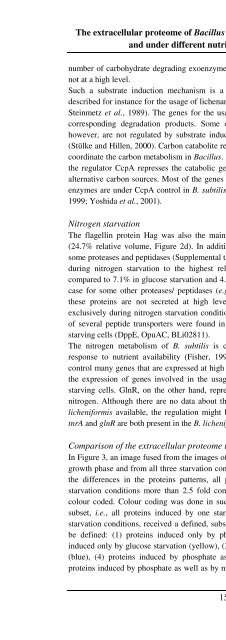The Staphylococcus aureus secretome - TI Pharma
The Staphylococcus aureus secretome - TI Pharma
The Staphylococcus aureus secretome - TI Pharma
You also want an ePaper? Increase the reach of your titles
YUMPU automatically turns print PDFs into web optimized ePapers that Google loves.
<strong>The</strong> extracellular proteome of Bacillus licheniformis grown in different media<br />
and under different nutrient starvation conditions<br />
number of carbohydrate degrading exoenzymes (Supplemental table Vb, Figure 1), although<br />
not at a high level.<br />
Such a substrate induction mechanism is a known regulatory phenomenon. It has been<br />
described for instance for the usage of lichenan and levan by B. subtilis (Tobisch et al., 1997;<br />
Steinmetz et al., 1989). <strong>The</strong> genes for the usage of these carbohydrates are induced by the<br />
corresponding degradation products. Some other catabolic genes, like amyE and xynA,<br />
however, are not regulated by substrate induction but only by carbon catabolite repression<br />
(Stülke and Hillen, 2000). Carbon catabolite repression is the global regulatory mechanism to<br />
coordinate the carbon metabolism in Bacillus. In the presence of the preferred sugar, glucose,<br />
the regulator CcpA represses the catabolic genes whose expression is required for utilising<br />
alternative carbon sources. Most of the genes encoding extracellular carbohydrate degrading<br />
enzymes are under CcpA control in B. subtilis (Henkin et al., 1991; Martin-Verstraete et al.,<br />
1999; Yoshida et al., 2001).<br />
Nitrogen starvation<br />
<strong>The</strong> flagellin protein Hag was also the main protein secreted from nitrogen-starving cells<br />
(24.7% relative volume, Figure 2d). In addition, nitrogen starvation led to the secretion of<br />
some proteases and peptidases (Supplemental table Vb). <strong>The</strong> main protease, Vpr, accumulated<br />
during nitrogen starvation to the highest relative volume in all three conditions (14.5%<br />
compared to 7.1% in glucose starvation and 4.5% in phosphate starvation). This was also the<br />
case for some other proteases/ peptidases (e.g., Ggt, BLi01747, data not shown), although<br />
these proteins are not secreted at high levels. <strong>The</strong> aminopeptidase YwaD was secreted<br />
exclusively during nitrogen starvation conditions. In addition, the substrate binding proteins<br />
of several peptide transporters were found in the extracellular protein fraction of nitrogenstarving<br />
cells (DppE, OpuAC, BLi02811).<br />
<strong>The</strong> nitrogen metabolism of B. subtilis is controlled by different regulatory proteins in<br />
response to nutrient availability (Fisher, 1999). <strong>The</strong> regulatory proteins TnrA and GlnR<br />
control many genes that are expressed at high levels in nitrogen starving cells. TnrA induces<br />
the expression of genes involved in the usage of alternative nitrogen sources in nitrogenstarving<br />
cells. GlnR, on the other hand, represses such genes in cells growing with excess<br />
nitrogen. Although there are no data about the regulation of the nitrogen metabolism in B.<br />
licheniformis available, the regulation might be similar as in B. subtilis, because the genes<br />
tnrA and glnR are both present in the B. licheniformis genome.<br />
Comparison of the extracellular proteome under the different starvation conditions<br />
In Figure 3, an image fused from the images of the extracellular proteomes of the exponential<br />
growth phase and from all three starvation conditions is presented. To gain an overview over<br />
the differences in the proteins patterns, all proteins induced in response to the different<br />
starvation conditions more than 2.5 fold compared to the exponential growth phase were<br />
colour coded. Colour coding was done in such a way that all proteins belonging to a spot<br />
subset, i.e., all proteins induced by one starvation condition or a certain combination of<br />
starvation conditions, received a defined, subset specific colour. Seven protein subsets could<br />
be defined: (1) proteins induced only by phosphate starvation (red colour), (2) proteins<br />
induced only by glucose starvation (yellow), (3) proteins induced only by nitrogen starvation<br />
(blue), (4) proteins induced by phosphate as well as by glucose starvation (orange), (5)<br />
proteins induced by phosphate as well as by nitrogen starvation (green), (6) proteins induced<br />
159













